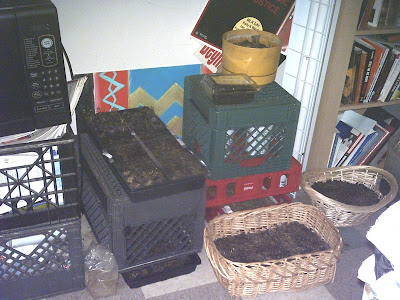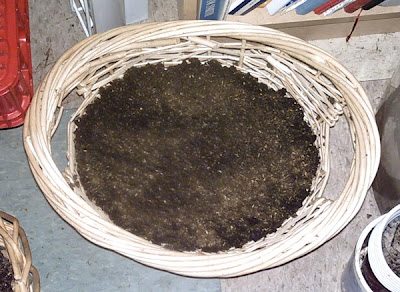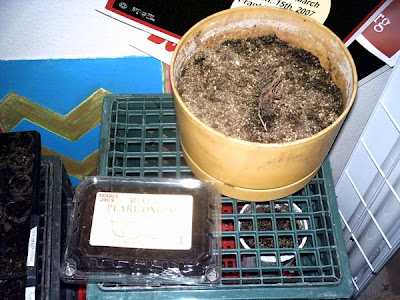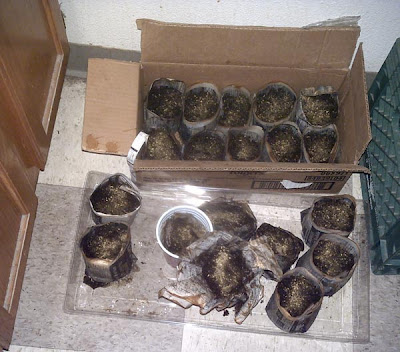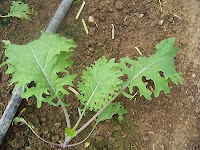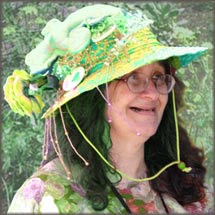Of the seeds I started on January 9:
- The Persian Garden Cress started coming up two days later, the scallions I planted in the other side of the flat started coming up two days after that. I am hoping that, with the daylight fluorescents, I can keep this flat indoors handy to the kitchen.
- I had a wicker basket that I started plants in outside over the summer. In fall, I planted catnip in it. I also stuck one lone garlic bulb in when I couldn't figure out where else to put it. I was keeping the basket just outside my window, until somebody reached in and took all the healthy catnip plants, leaving only a few stragglers (and the garlic). I replanted in with dill and three more garlic cloves, planning also to keep this indoors by the kitchen. The dill started sprouting on the 13th and two more garlic shoots had poked up on the 17th. The whole bed also bloomed with fungus; I thought it was clever to mulch it with coffee grounds, and I made the mistake of using old grounds. Scraping the surface, and sprinkling with "compost starter" (lots of beneficial microbes) helped to tone it down, but it still kept coming back in spots. I finally took the whole thing outdoors, hoping the fresh air and cold will help.
- I started another small wicker basket for the kitchen with chives and cilantro; the chives started sprouting on the 14th and the cilantro on the 17th.
- I started some Dwarf Curly Parsley soaking on the 9th and on the 10th I put it in a plastic yogurt container with drainage holes cut in the bottom. It began sprouting on the 16th.
On the 13th I bought more seed-starting soil and two 72-cell, covered planting trays; one with peat pellets, and one without. In the peat tray, I started:
- 6 Canterbury Bells
- 6 leeks
- 6 Red Winter kale
- 9 "Marvel of Four Seasons" lettuce
- 9 Moss Green Curled parsley
- 9 "Johnny Jump-Up" violas
- 9 King Henry violas
- 9 winter pansies
- 9 Swiss Giant pansies
I also planted, on the 13th, a wicker basket of spinach for the kitchen.
On the 16th, all 9 lettuce, 2 kale, 1 leek, 1 canterbury bell, 1 k.h. viola had sprouted; on the 17th 1 more kale, 1 more leek, 1 swiss pansy, and the first spinach sprouts. From then to the 20th, more Canterbury Bells have come up, leeks, kale, violas of both kinds, and pansies of both kinds.
On the 14th I put starting soil in part of the second tray and started 6 verbena, 6 Rosa Bianca eggplant, and 12 Summerlong basil. 5 cells of basil and 1 eggplant sprouted on the 17th; two verbena on the 19th, two more eggplants just came up on the 20th.
On the 15th I started soaking some Moss Green Curled parsley. On the 16th I also started soaking bell peppers, several kinds of tomatoes, several kinds of kale, leeks, and Swiss Giant pansies. I made my first newspaper pots, filling them with peat moss moistened with worm tea, and started 4 pots of tomatoes: 1 pot Early Girl, 2 pots Matina, and 1 pot Brandywine.
On the 17th, I filled more of the cells in the starting tray and planted 6 cells of Sweet Million cherry tomatoes, 6 Sun Cherry, 7 Brandywine, and 5 Oregon Spring. I also planted a yogurt-container pot of Moss parsley.
Also on the 18th, I planted sweet bell pepper seeds in a little plastic container that pearl onions came in. It has a flip-top lid, and air slits along the sides of the lid and the base.
The spinach basket began growing mold and some of the spinach sprouts wilted. On the 18th, after scraping off as much of the mold as I could and sprinkling the surface with Soil Alive and Dr. Earth Compost Starter, I planted some more spinach seeds, some leek seeds, and three garlic cloves. As of the 21st, four spinach shoots are going strongly, and two new ones are coming up. There is very little mold. I am thinking, though, that the spinach may germinate much better outside.
Some of the cells and pots in the seedling trays also began showing mold. I scraped it off and sprinkled them with the Soil Alive and Dr. Earth Compost Starter mix. I left the plastic lids off.
On the 19th, I made more and better newspaper pots, and potted the rest of the tomato and pansy seeds that had been soaking. Unfortunately, I did not label which was which. I told myself I would remember, and write it down tomorrow. I did not.
I know that in one box I have four pots of Marianna's Peace at one end, two pots of Swiss Giant pansies at the other, and four pots of Florida Petite tomatoes in the middle. I should be able to tell the difference between those soon after they show leaves; Marianna's Peace is a potato-leaved tomato, Florida Petite is not, and Swiss Giant are, well, pansies.
I used the plastic lid off one of the seedling trays to hold the other newspaper pots. In the middle are the pots I started the 15th, easily identifiable by appearance; each of my first newspaper pots was unique in its own weird way. At one end are some more Early Girls, and at the opposite end are more Brandywines. I think Brandywines are also potato-leaved, so I may be able to sort those out, too.
While the indoors temperature is too high for spinach germination, which prefers 40 degrees or so, it is not quite high enough for tomato germination, which prefers 75 to 80 degrees. I can put the spinach outside to germinate, but I don't know how to heat up the tomatoes without seedling heater mat, which costs more than I can afford. I'll just have to wait and see. I did plant several seeds per pot. If all of the pots do sprout, I'll be giving away most of the seedlings.
On the 19th, I planted catmint in a little wicker basket. When that grows up into a nice healthy mound, I'll take it into Real Change for Sid the Cat.
And that's that. I am going to try more winter sowing outside this week; I'm not going to start anything more inside until I get more shelving!


